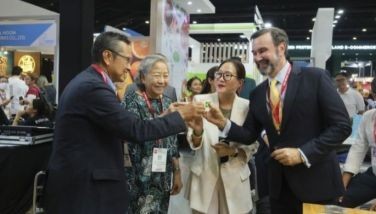Ivory story: A way to discredit the church

Because of the bad publicity that the Catholic Church got from that October issue of National Geographic that featured the Ivory Trade that author Bryan Christy tried to link to Msgr. Cristobal Garcia, Cebu Archbishop Jose Palma called a press conference at the Cebu Archdiocese in a show of transparency. What surprised the Cebu media was the revelation that Msgr. Cris Garcia had already been replaced from his post as chairman for the Commission on Worship and was being investigated by the Holy See on a sex incident that happened way back in 1982 in the United States.
Actually we knew this last June because that was the time Msgr. Garcia was replaced by Fr. Ramon Ofredo as the spiritual director of Bukas Loob sa Diyos (BLD), however it was only last Wednesday that this case was linked to that sex scandal 20 years ago. Actually, the Manila Bulletin already reported this incident at that time. But as we all know, the wheels of justice which we describe as “snail paced” in the Philippines is just as slow in the Holy See. So that case is still under investigation and has nothing, I repeat, nothing to do with the Ivory issue that has been blown out of proportion.
Meanwhile, I got a call from my good friend, Legal Environmentalist Atty. Antonio Oposa who reacted to my mentioning his name in my previous article. Atty. Oposa (Oposa and my wife Jessica both hail from Bantayan Island, which has many centuries old religious ivory relics) clarified that he was not after Msgr. Cris Garcia or the Catholic Church for that matter. He merely wanted to know what ever happened to the elephant tusks that was confiscated by the Bureau of Customs (BoC).
Allow me to take a quote from a dear friend, CDN Columnist Malou Guanzon Apalisok who wrote, “In the Philippines, government corruption is still at the heart of the problem if we examine how smuggled tusks valued at tens of millions of pesos disappeared from under the noses of the Philippine Customs officials in 2005, 2006 and 2009. The illegal supply was reportedly intended for China and Japan, but some unscrupulous businessmen with ties to corrupt authorities were able to get a slice of the illegal shipment.
So why blame Catholic devotees? Catholics with a taste for the fine art buying either legal or illegal ivory as undermining CITES is pure hogwash. The NatGeo article is anti-Catholic but tries to obscure its slant under the hide of wildlife protection drive.” Thanks Malou for telling us the truth that the ivory article was after all an effort to discredit the Catholic Church. Shame!
* * *
Last Wednesday evening, we attended the formal appointment of our good friend, Eduardo Graham Gonzales, as the Honorary Consul to Mexico in Cebu by Ambassador Tomas Javier Calvillo of Mexico at the Manila Room of the Marco Polo Plaza Hotel. What made the affair extra special was the acceptance speech by Consul Gonzales, which was more than a simple acceptance speech, but a short albeit historical essay between the two cultures of Cebu and Mexico.
Let me just share a few excerpts as pointed out by Consul Gonzales who said, “The famous Manila-Acapulco Galleon Trade was started in 1565 and continued for 250 years until 1815 when Mexico fought and won their Independence from Spanish rule. At the start of these 250 years, Miguel Lopez de Legazpi, who first landed in Bohol was designated the first Spanish Governor-General of Las Islas Filipinas. It is interesting to note that ‘Las Islas Filipinas’ was thereafter administered by the Viceroyalty of ‘Nuevo España’ which is Mexico today and all of the Governor-Generals for the next 200 years were from Mexico.”
Let me add my own research that the Galleon trade between Mexico and the Philippines produced the first Filipino international seafarers because many Spanish or Mexican crew of the Galleons did not want to return back to Mexico and therefore the Spaniards had to conscript Filipinos to become their ship’s crew. Today we have become world class seafarers.
Consul Gonzales added, “The Galleons brought in the missionaries, Mexican traders and new agricultural products like corn, sugar cane, cocoa, chili, potato, tomato, avocado, cotton and tobacco. During this period, the Philippines and Mexico experienced cultural exchanges in language, religion, food, clothes and dances... including the fiestas.” Indeed, the Filipino tradition of holding fiestas all came from Mexico.
One thing in Consul Ed’s speech that wasn’t known was during World War 2 Mexico sent the so-called “Aztec Eagles” to fight with the Americans in the Liberation of Luzon. Again, congratulations Consul Ed Gonzales, perhaps we should now start calling you Consul “Speedy” Gonzales.
* * *
Email: [email protected] or [email protected]
- Latest
- Trending




























